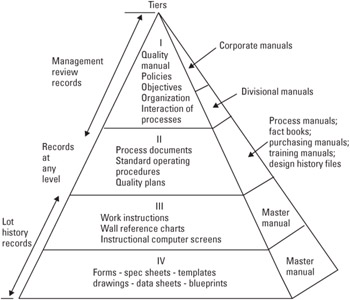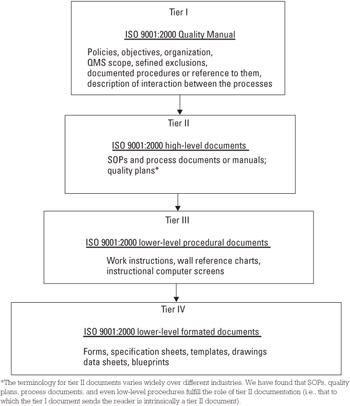4.2 The Four-Tier Pyramid Concept
|
4.2 The Four-Tier Pyramid Concept
Our first task, then, is to remove the previously stated ambiguities and describe clearly what constitutes the general set of QMS documents so that our model is directly applicable to an effective documentation structure. As a memory aid, we will use the tier concept (i.e., tiers I–IV), but with a more specific set of definitions.
A useful icon in this regard is to place the four tiers in the form of a documentation pyramid (see Figure 4.1) [1].

Figure 4.1: The four-tier operational pyramid concept—ISO 9001—2000 guidelines.
4.2.1 Matrix Format
The four tiers can also be described in the form of a table (e.g., see Table 4.1). The matrix form provides another class of information related to the specific content of a given tier [2].
| Tier | ISO 9000 Category | Content Description | Deals with... |
|---|---|---|---|
| I | Quality manual Corporate Divisional Departmental | A time-independent document describing the organization's policies written in conformance with the Standard. Scope of QMS Details of exclusions Documentation of quality policy Documentation of quality objectives Description of organization Identification of processes Description of processes interactions Inclusion or reference of procedures | The organization's response to each SHALL The "rules of the house"—the methods used to ensure compliance Definition of responsibility |
| II | Process documents and high-level procedures SOPs Departmental operating procedures Business plans Quality plans | Time-dependent documents that describe either the overall processes of the organization or a combination of process and high-level procedures Enterprise processes Six mandatory procedures Documents needed to ensure the effective planning, operation, and control of the processes Employee handbook | Purpose—what, when, where, who, and why at a high level Flow of information from area to area, department to department, building to building |
| III | Lower-level procedural documents Wall reference charts Instructional computer screens Work instructions Directions | Time-dependent, detailed step-by-step work instructions on how to complete a task (e.g., at the operator or bench level)—sometimes integrated into tier II documents Purchasing work instructions Manufacturing work instructions Training syllabus | How one does the job—tells the reader in a step-by-step fashion Provision of the necessary data to perform the tasks |
| IV | Unfilled-in forms, graphics, or spec sheets Templates Blueprints Schematics Specifications Drawings | Generally time-independent documents that specify the data requirements called out in the various documents and/or specific data sources, or graphically indicate requirements or state specifications Many of the forms are used as records once they are filled in and filed, although specific records are required at all levels Complementary documents to support work instructions | The forms used to demonstrate that a procedure requiring either data taking or data input was done Drawings and/or specifications used in manufacturing or troubleshooting The templates required to measure and fabricate |
4.2.2 Operational Tiers
We have specified in Table 4.1 that the documentation pyramid represents the operational flow of information (i.e., day-to-day processes carried out by use of dynamic and current documentation). That is why records are not included in tier IV. This is contrary to common usage, which we believe is incorrect from a taxonomy standpoint. We realize that this is a fine point, yet it causes considerable confusion among QMS designers.
Records should be listed as a distinct category of documentation within the QMS documentation umbrella. Although it is unnecessary to consider records in the form of a taxonomy, it is sometimes quite useful for organizational purposes. For example, the following records could be filed according to tiers:
-
Management review minutes are records at the tier I level because they are part of the policy-making top-management control system.
-
Corrective action reports are tier II records because they are directly associated with a SOP.
-
A completed/filled-in tier III work instruction (e.g., verification test instruction), becomes a tier III record.
4.2.3 Guidelines
The proposed documentation taxonomy—policy, process, procedure, form— fits readily into this documentation pyramid. However, the tiers and various examples of documents are merely guidelines. It is the quality manual, quality objectives, identified processes and their controls, control plans where applicable, six specific procedures, supplemental documents if applicable, work instructions if applicable, and records that are clearly mandatory hierarchal documents in the Standard.
4.2.4 Four Tiers
The four-tier operational pyramid does emphasize the impact of the quality manual (manual) on the entire documentation structure, although—as noted—the pyramid is only meant to be a guideline because it does not replace the actual linkage that must be present from document to supplemental document.
4.2.5 Navigation Is Key
The four-tier structure readily provides levels for the type of documents that are usually encountered. However, some companies have as few as two defined levels and some as high as six defined levels. The number of levels is irrelevant. What is relevant is that they are presented in a way that aids the reader to easily navigate throughout the system.
4.2.6 Clearly Link Lower Tiers from the Manual
What is usually found is that the ISO management representative is cognizant of the total documentation structure but everyone else has great difficulty locating specific documents within the overall taxonomy. As a result, during an interview, when the auditee becomes confused over where to locate a document, I always suggest that they start with the manual and work down through the documented system. This usually helps, but only when the manual is clearly linked to the lower tier documents.
For online systems, this is readily accomplished with hyperlinks. However, it must be made relatively simple for the reader to quickly find the manual icon on the network, and with it the links.
4.2.7 Waterfall Effect
The use of a four-tier pyramidal structure for the QMS documentation is recommended to maximize communication to users. Once the four-tier hierarchy has been established, the total documentation system tends to behave with a waterfall effect (i.e., the number of process documents are less than the number of procedural documents, which in turn are less than the number of forms). We have illustrated this effect graphically in Figure 4.2.

Figure 4.2: ISO 9001—2000 documentation waterfall effect [3].
In this figure, we have made the assumption that the quality manual is a stand-alone document (i.e., only contains quality policy statements and refers to lower tier documents). As demonstrated later, this is not the only possible configuration for the system, but it greatly helps to describe our concept.
The tendency for documentation growth must always be challenged. However, the use of the described techniques will tend to minimize this growth.
4.2.8 ISO 9000 Hierarchal Drivers
In Figure 4.3, we see that the four-tier concept is universal (i.e., the Standard defines the quality manual responses, the quality manual responses confine the content of the second-tier documents, and the tier II documents drive the content of the procedures/work instructions). In this manner, the executive rules are transformed into management controls that are then transformed into operational directives.

Figure 4.3: ISO 9001—2000 hierarchal drivers.
Thus, the design of an effective QMS is holistic in that it is more than the sum of its parts. Unlike the engineering design of a personal computer's printed wiring assembly, there must be a powerful motivational element present within the QMS environment. For example, there is no need to motivate the electrons to flow efficiently within the printed circuit board's copper tracks, but there is an extremely important requirement to create a symbiotic relationship between the inert document's pages and the dynamic application of those documents by human beings. Thus, there is always an affective requirement as well as an effective requirement in the design of the QMS.
The QMS acts as a living organism, and this is why it is so difficult to create the QMS in the first place and then to effectively maintain the system. However, it is the inherent ability of the four-tier structure to enhance informational flow that increases the probability of a successful QMS [4].
[1]We have just seen the hierarchy of policy, process, procedure, form used in the open literature: Bradel, Teri, "Quality Makes the Grade," Quality Progress, March 2002, p. 86.
[2]Although the terms quality policy, process, and procedure are defined in ISO 9000:2000, a pathological logic exists in the application of these concepts because a procedure is defined as a "specified way to carry out an activity or a process." It is a Catch 22 situation. Only six procedures are called for but we are to identify our processes, and it takes a procedure to document the process. As a result, our definitions are based on the work of Horn, Robert E., Demystifying ISO 9000, Second Edition, Information Mapping, Inc., Waltham, MA, 1994, pp. 5–6. In Mr. Horn's work, policy, process, procedure, and form are clearly defined.
[3]The terminology for tier II documents varies widely over different industries. We have found that SOPs, quality plans, process documents, and even low-level procedures fulfill the role of tier II documentation (i.e., that to which the tier I document sends the reader is intrinsically a tier II document).
[4]The importance of human interfacing with the QMS is extremely well documented. A source of original and lucid studies in this matter is available in the Quality Management Journal, a publication of the ASQ (e.g., Vol. 4, No. 2, 1997).
|
EAN: 2147483647
Pages: 155